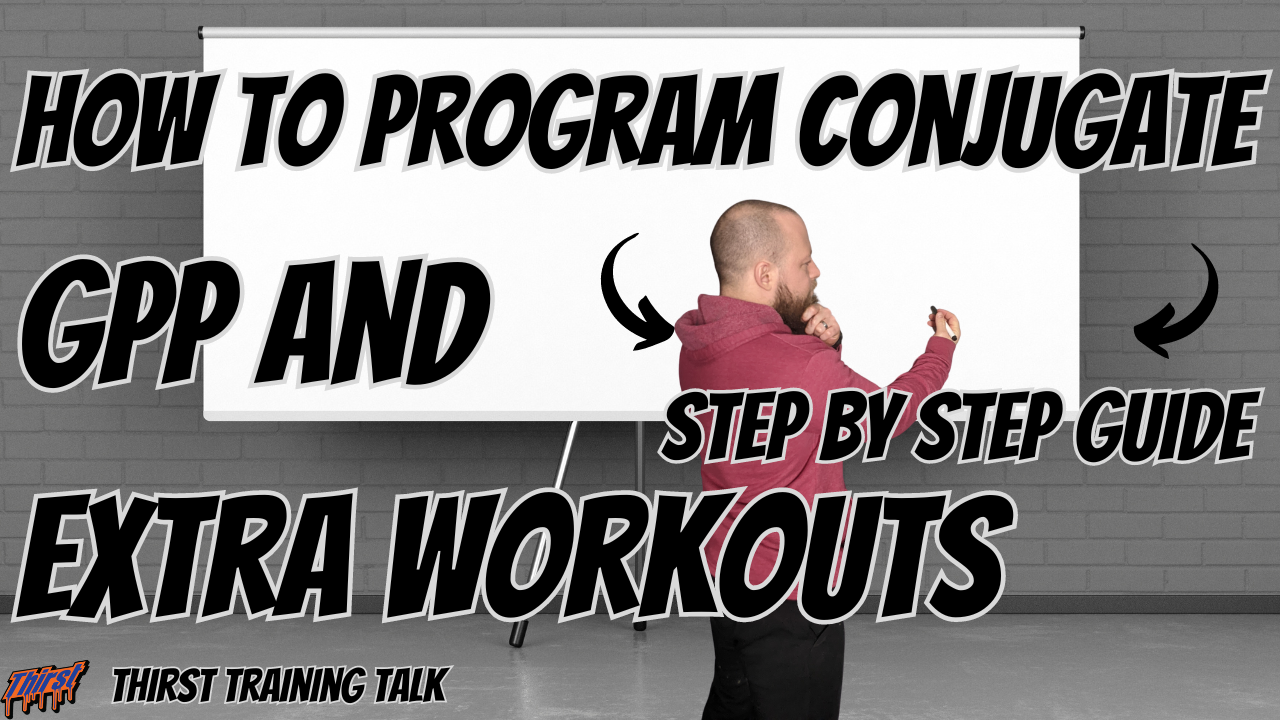GPP and Extra Workouts in the Conjugate System: A Complete Guide
The conjugate system, popularized by Louie Simmons, has become a cornerstone of modern powerlifting training. While many lifters focus on the max effort and dynamic effort methods, the often-overlooked component of General Physical Preparedness (GPP) and extra workouts plays a crucial role in optimizing your training results. In this comprehensive guide, we’ll explore how to effectively implement GPP workouts to enhance your powerlifting performance.
Want to see how I implement and create these workouts? Watch the video below.
Understanding GPP in the Conjugate System
GPP workouts serve three primary purposes within the conjugate system:
- Elevating your base conditioning level
- Enhancing recovery between primary training sessions
- Addressing weak points and lagging muscle groups
These supplementary sessions are designed to complement your main training days – max effort lower, max effort upper, dynamic effort lower, and dynamic effort upper – without compromising their effectiveness.
Ideal Weekly Training Structure
The optimal layout for a conjugate system training week typically follows this pattern:
- Monday: Max Effort Lower
- Tuesday: GPP/Extra Lower
- Wednesday: Max Effort Upper
- Thursday: GPP/Extra Upper
- Friday: Dynamic Effort Lower
- Saturday: Dynamic Effort Upper
- Sunday: Rest
This structure ensures adequate recovery time between similar movement patterns while maximizing the benefits of your GPP work. You’ll notice there’s at least 48 hours between similar body part training and 72 hours between similar training types (max effort vs. dynamic effort).
One-Day GPP Template: Full Body Approach
For lifters limited to one extra training day per week, here’s an efficient full-body GPP template designed to be completed in under 60 minutes:
Lower Body Focus (20-25 minutes)
Start with a primary squat or hinge-based movement. Belt squats, goblet box squats, or heel-elevated squats work exceptionally well here. Perform 3-6 sets of 15-30 reps, maintaining 3-5 reps in reserve. The goal is to achieve a substantial pump without reaching failure.
Posterior Chain Work (15-20 minutes)
Superset hamstring-focused movements with complementary exercises. Consider pairing:
- Band leg curls (3 sets of 20 reps)
- Reverse sled drags (3 sets of 25 yards)
Upper Body Development (15-20 minutes)
Incorporate pressing and pulling movements in supersets:
- Neutral grip dumbbell bench press (3 sets of 15-20 reps)
- Inverted rows (3 sets of 15-20 reps)
Finishing Work (10-15 minutes)
Complete your session with direct arm work and shoulder care:
- Cable pressdowns (3 sets of 15 reps)
- Seated dumbbell curls (3 sets of 15-20 reps)
Two-Day GPP Split: Optimizing Recovery
When you can dedicate two days to GPP work, you can further specialize each session:
Lower Body GPP Day
- Goblet Squats: 3 sets of 20 reps
- Back Extensions: 3 sets to muscular pump
- Band Leg Curls: 3 sets of 40 reps
- Kettlebell Swings: 10 reps EMOM for 10 minutes
Upper Body GPP Day
- Chaos Bench Press: 3 sets of 20 reps
- Machine Row: 3 sets of 15 reps
- Band Pressdowns: 150 total reps
- Superset:
- Lat Pulldowns: 3 sets of 20 reps
- Dumbbell Lateral Raises: 3 sets of 20 reps
Key Principles for Effective GPP Training
1. Recovery Focus
Remember that these sessions are designed to enhance recovery and promote blood flow, not to test your limits. Always leave 3-5 reps in reserve on every set.
2. Time Management
Keep sessions between 45-60 minutes. This timeframe is sufficient to achieve the desired stimulus without overtaxing your recovery capacity.
3. Movement Quality
For athletes with mobility restrictions, incorporate mobility work between sets:
- Hip flexor stretches between squat sets
- Pec and lat mobility work between pressing movements
- Hip mobility drills during posterior chain work
4. Density Training
These workouts essentially function as density training – completing significant work volume in a compressed timeframe. This approach promotes:
- Enhanced blood flow
- Improved recovery
- Targeted muscle growth in lagging areas
- Increased work capacity
Post-Competition Implementation
GPP workouts become particularly crucial after competitions. Following a meet, when you’ve likely reduced volume in favor of intensity, these sessions help:
- Rebuild work capacity
- Facilitate recovery from high-intensity periods
- Gradually reintroduce training volume
- Maintain conditioning levels
Common Mistakes to Avoid
- Treating GPP sessions like competition
- Neglecting rest periods
- Using too much load
- Extending sessions beyond 60 minutes
- Programming them too close to main training days
Conclusion
GPP and extra workouts are integral components of the conjugate system, not optional extras. When programmed correctly, they enhance recovery, improve work capacity, and address weaknesses without compromising your primary training sessions. Remember, the goal is to stimulate, not annihilate – these sessions should leave you feeling better, not beaten down.
For optimal results, start conservatively and gradually increase the density of these workouts as your work capacity improves. Pay attention to how your body responds and adjust accordingly. With consistent implementation, you’ll find these “extra” workouts become essential tools in your strength development arsenal.
Interested in using the conjugate system in your own training? Join my Train Heroic group where you can get conjugate training for less than $1 per day.








